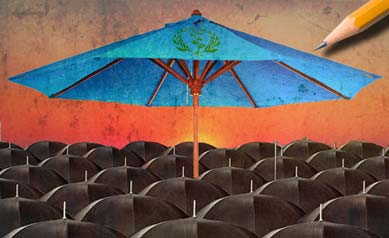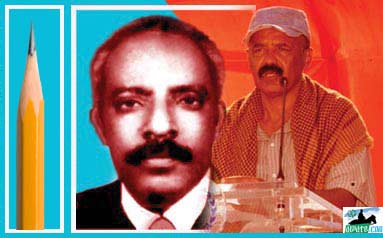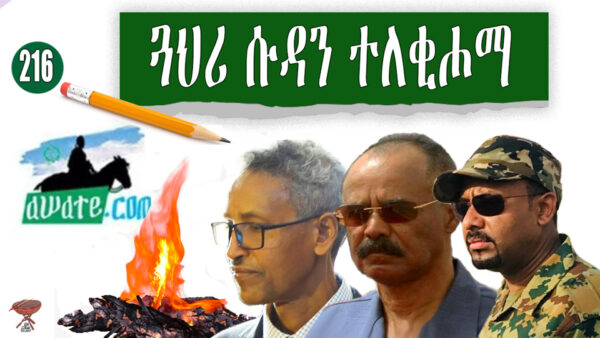Strengthening The ENCDC

This editorial was published on April13, 2006 under the title “Strengthening The EDA which we changed to “Strengthening The ENCDC”. Of course, some points that were relevant ten years ago might not be so anymore. But most of the points are applicable today if only the Eritrean Democratic Alliance (EDA) is replaced by ENCDC (Eritrean National Council for Democratic Change). We decided to republish the editorial ten-years after it was first published.
It has been slightly more than a year since the newly reconstituted Eritrean opposition umbrella group, the EDA: Eritrean Democratic Alliance (“Kidan” or “Tehaluf” in Tigrigna and Arabic respectively) was formed in Khartoum, Sudan. In the previous editorial, we opined on the external changes that have to come about that will strengthen the Eritrean Democratic Alliance, particularly from the Ethiopian government. We find it necessary to restate the main points of our last editorial:
- The government of Ethiopia must abandon its foreign policy of ambiguity and secrecy and make its position known on whom it considers its strategic allies: is it the PFDJ? Is it the Eritrean Alliance? Or is it only select groups, individuals or parties within or outside the Alliance? We argue that it should be the Alliance because it is the only political entity in Eritrea’s body politic that is elected and reflects the broad spectrum of Eritrea’s diversity—ideologically and demographically.
- We also called on the government of Ethiopia to treat the case of Eritrea with the importance it deserves. Among many of the complications of the Eritrea-Ethiopia relationship is psychological in nature and assigning the case to low-level cadres only encourages “Bremmerism”: arrogance displayed by self-styled Bremmer who considers it is an occupational perk to disrespect opposition figures.
In protection of its national interest, the government of Ethiopia is free to support or oppose whomever and whatever it wishes. But if its policy of ambivalence and micromanaging the EDA is part of its national interest, then the EDA should factor that in its assessment of who are its friends and foes as well.
Last week’s editorial dealt with the relationship between the EDA and Ethiopia. Of more significance, and our emphasis today, is of the changes that the EDA must undertake—changes in its bylaws, it charter, and in its electoral process. We hope the EDA will accept these recommendations in the spirit that they are being delivered—constructive input from those who wish to strengthen the Alliance and to succeed in its efforts to attract more Eritreans to its cause: bringing justice, democracy and political pluralism to Eritrea.
A. Equitable Representation
Prior to the establishment of the EDA, many commentators including the Pencil, described the need for an all-inclusive umbrella group as the equivalent of a “government-in-exile” or “assembly-in-waiting” or “shadow-government.” By lumping every Eritrean interest group, this body was to act like an “assembly” (Baito or Mejlis in Tigrigna and Arabic respectively) which would, by virtue of its diversity, guarantee that all Eritrean voices are heard. Much needs to be done here to improve the strength of the assembly but it is fair to say that many interest groups—those calling for ethnic rights, religious rights, democratization—have at least one party that they can identify with. The same cannot be said of the Central Leadership and the Executive Office which probably has to do with the bylaws of the EDA.
We say “probably” because we haven’t seen the bylaws. But according to the description provided by its chairman, Mr. Berhane “Hanjema,” and its information officer, Mr. Mengesteab Asmerom, the makeup of the EDA’s legislative arm was decided on the following basis:
Of the sixteen organizations that make up the EDA, eleven were considered big enough to be given two votes/seats each (11 x 2 = 22) and five were categorized small and given one vote/seat each (5 x 1 = 5). This categorization resulted in a 27 member Central Leadership, with each organization nominating individuals for the seats it is assigned.
And what was the criteria used to decide which organization got one vote and the other two votes? According to Mr. Berhane Hanjema:
Here are some of the criteria that were used: does the organization have a political program? Was this approved at an organizational congress? Has it introduced its leadership to the people? How extensive are its diplomatic initiatives? Is it engaged in the fields of news and information? Does it have a military establishment? And there were other factors.
We hope that the “other factors” include the obvious: how big is the organization in terms of membership? Branch offices? Staying power?
While we understand the motives behind the 2:1 compromise, we suggest that it is undemocratic (and, therefore, unfair) because it is under-representing the voice of the large organizations and, therefore, their members and supporters. The large organizations are not only twice as big as the tiny ones; they are, in some instances, 5 or 10 times bigger. As a result of the 2:1 compromise, what we have now is the worst of all worlds: the big organizations, which have multiple offices, full-time politicians, and a long history of regular congresses and elections, are not incentivized to see the EDA as their organization and to work for its success. In some instances, they see their own organization as being bigger than the EDA. Conversely, the small ones are too small to be effective even if they want to work for the betterment of the EDA.
The best way to dramatize this disparity is as follows: unless this system is changed, some large organizations will only have twice as many votes as the new small organizations which are slated to join the EDA in its next meeting. This bylaw has to change and change immediately and votes must be given in accordance to the size of the organizations. The best way to promote democracy is to practice it—and democracy is all about numbers.
Recognizing this obvious fact will require maturity and selflessness on the part of the small organizations. It is better to be a small contributor to an effective opposition than a big contributor to a paralyzed opposition.
B. Party Recognition Criteria
Any group of people is free to call itself a party, but the EDA should have criteria for defining a political party. Knowing well its controversial nature, we suggest that the EDA consider as a working paper the now-banned Draft Law on Political Organizations that was prepared by the Eritrean Commission on Drafting Electoral Laws in 2001. Of special help would be Article 6.5 which stated:
In order that the composition and unity of the founders as well as their ethnic and religious identities may reflect the pluralistic nature of the Eritrean society: a) At least 2/3 of them must originate from five nationalities at the minimum; b) At least 1/3 of them must be followers of the Islamic or Christian faiths.
A well-defined criterion would eliminate the tendency towards continuous fragmentation of political groups and it would force politicians to actively recruit members from groups outside their immediate comfort zone. There should be no “grandfather clause” privilege: even existing organizations would have to be given a deadline whereby this goal would have to be reached via recruitment and coalition building. Unless the EDA implements this kind of criteria, individuals calling themselves parties will continue to be formed from narrower and narrower slices of the Eritrean society, continuously polarizing the body politic.
C. Streamlining/Diversifying the Executive Officers
The executive arm of the EDA is the Executive Office, also described as the equivalent of Cabinet of Ministers. The nine members that make up the Executive Office are elected in a direct vote. What criteria is used to elect the officers? According to Mr. Mengestab Asmerom:
Those nominated to the executive office were elected not on the basis of their ability to represent their organizations, but on two benchmarks: merit, and their ability to devote 80% of their time to the goals of the Alliance. What explains the fact that these nine members are from different organizations is the recognition that qualified people who meet the stated criteria are present within each organizations and the effort to widen the scope of participation.
While we understand the sentiment behind this rationale, which is a contributor to confidence-building and encouraging participation, we consider it a process that is no longer useful in the second year of the EDA. To begin with, given its size, the EDA has a fairly large Executive Office. Until such time as the EDA has the resources to back up the presence of so many officers, we recommend streamlining and consolidating the number of offices to seven:
- Chairman
- Vice Chairman
- Secretary & Information
- Foreign Relations
- Community & Social Affairs
- Economy & Finance
- Security
Of significant importance should be the diversity of the leadership of the EDA. Since the 1940s, Eritreans have repeatedly demonstrated their desire to have a political leadership that reflects the diversity of Eritrea. The most glaring weakness of the current EDA leadership is that it does not include a single female member at the Central Leadership and the Executive Office level. The EDA must double and redouble its efforts to promote women to positions of authority. The second weakness is the absence of the young in its ranks. The third oversight, which has been repeatedly exploited by cynical members of our intelligentsia, is that the EDA leadership does not present a good balance of individuals with Christian and Moslem names. This must be rectified, again, in recognition of Eritrean diversity.
It is also our understanding that the Chairman of the Executive Office is given broad latitude in the presentation of portfolios to his “Cabinet.” While we understand the need to empower the Chairman of the Executive Office to form his/her own team, we believe that there should be a role for the Secretariat of the Central Leadership in the designation of the offices.
When it comes to the Chairman of the Executive Office, it may be unavoidable to settle for a compromise candidate, politics being what it is. But it would be highly preferable for the post to be openly contested and for the candidate with the most votes to win and for the losing candidates to rally behind the winner immediately.
D. Transparency
Even in the midst of war and infiltration attempts by the enemy, the fronts (ELF and EPLF) always ensured that their congresses were open to observers. The ELF congresses went one step further and actually invited civilians to their congresses. EDA’s semi-annual meetings must be open to the civil society. Journalists, community activists, human rights advocates should be invited at least as observers. Openness serves not only the public interest but the member organizations of the EDA—whose members will be less susceptible to dark conspiracy theories that are woven by people who specialize in sensationalizing non-events.
E. Revisions To The Charter
The Charter is an agreement between political organizations that specifies shared outlooks for the two phases envisioned by the EDA. Phase 1 is the present, the period of waging of the struggle against PFDJ. Phase 2 is the post-PFDJ nation-building period and is further divided into different periods:
Provisional Government (1 year duration):
Make up: Opposition parties
Role: free political prisoners, promote national unity, and organize national conference.
The National Conference:
Drafts transitional charter
Appoints transitional assembly
The Transitional National Assembly:
Drafts press laws
Drafts electoral, political organization laws
Establishes a transitional government
Checks/balances the transitional government on the basis of the transitional charter drafted by the National Conference
The Transitional Government (2 year duration)
Establishes constitutional commission
Administers general election
Repatriates Eritrean refugees
The Charter spends more time discussing the procedure that will be implemented in Phase 2 (post PFDJ Eritrea) than it does in Phase 1 (the struggle period to remove PFDJ.) This should answer critics who worry about what will happen once PFDJ is gone. It should also invite questions and discussions such as: why would it take up to three years to repatriate Eritrean refugees who have been languishing in refugee camps for decades? What are the provisions for including forces that might actively participate in bringing about change inside Eritrea in the provisional government?
Instead, much of the criticism against the Charter has been waged by simply pressing emotional buttons like “article 3 and 4”, “secession”, “sheria”, “jihad”, and “tribalism.” The EDA shares part of the blame in this development because it has not forcefully separated itself from the ENA. In fact, if one is searching for EDA charter or program, one is more likely to find ENA information than EDA information.
“Article 3 and 4” have been used as shorthand for criticism of two articles in the charter of the ENA and the criticism has been, innocently or maliciously, carried over to the EDA. The two articles deal with the degree of religious and ethnic autonomy in future Eritrea. In terms of religion, Moslems were given the right to Sheria in matters that affect their personal lives; in matters of ethnic rights, ethnic groups were given rights that extend all the way to secession. That was in the ENA charter.
- Let’s begin with the issue of ethnic autonomy. In the EDA charter, as opposed to the ENA charter, there is no right granted to ethnic groups to secede. On the contrary, the charter talks at some length about the importance of having a unified country: in its preamble, as well as in the two sub-articles of the first article (1.1 and 1.2). However, for the sake of clarity, and to eliminate all doubts, the EDA should explicitly state that it considers the unity of the Eritrean people and their land as sovereign and inseparable and that the rights of ethnic groups do not extend to secession.
- In reference to the religious autonomy, the charter says the following in Article (1)(5):
Under a national constitution, Muslims have the right to implement Sheria in matters that affect their lives. So do Christians and traditional faith adherents: they have the right to observe their religious edicts and traditional laws.
This is a vast improvement over the previous ENA version, enough of an improvement that Mr. Mengestab Asmerom of ELF-RC said:
For me, since the issue of Sheria is now within the context of a constitution and to be decided by the people, I am of the view that it has been handled properly.
Still, there is a lot of room for improvement in this version, particularly given its inherent contribution in being exploited by demagogues. The way it is written, it implies that Muslims have more rights than Christians and followers of indigenous faiths who, in turn, have more rights than those who may be atheists, who are not mentioned at all. As long as all parties recognize that the national constitution is supreme, the assurances that religious and non-religious Eritreans need that their rights shall not be infringed upon by the State can be written in a manner that doesn’t spell out Muslims, Christians or traditional faiths. For example, we do not see why any organization would object to a simple language like:
The national constitution shall be the supreme law of the land. Within the parameters of the constitution, citizens shall have the freedom to exercise their beliefs and religions as they see fit.
The only question then would be “what are the parameters of the constitution” and the answer would be that it is something that will be decided by a representative constituent assembly in Phase 2 of the struggle.
- There is also the issue of National Conference. In the ENA charter, this issue was given high prominence but was postponed to Phase 2 by the EDA as something that can only be accomplished in Eritrea following the fall of the PFDJ. We believe that this is something that requires revision.
It is true, as Mr. Mengestab Asmerom explained in his interview with Awate, that any gathering of Diaspora Eritreans would raise the question of legitimacy: who are you and why do you presume to speak on behalf of an Eritrean segment? It is also true that many consider “national conference” as a stealth political party to replace the EDA. But this stance is denying an avenue to Eritreans who want to participate and contribute—without having to join the EDA. It is denying the EDA the opportunity to listen to unfiltered viewpoints of the Eritrean people. It should not escape the attention of the EDA that the Diaspora community accounts for almost a third of the Eritrean population: it is sizable and diverse enough to convene a National Conference. Moreover, there is nothing that would hinder a Second National Conference currently staged for Phase 2.
Only individuals who have shown true commitment to Eritrean unity, harmony and reconciliation should be included in National Conferences.
4. Finally, there is the issue of mode of struggle. The charter deftly handled the question of whether the mode of struggle would be peaceful or armed by stating that the Central Leadership would answer that on as-needed basis. But the record is not encouraging as at least three armed groups have continued to issue communiqués of their skirmishes with the Eritrean army. Were their actions approved by the Central Leadership?
The late Seyoum Ogbamichael, chairman of ELF-RC, used to say, “our goal is not to bring more problems to the Eritrean people, but solutions. We are for political pluralism, but not military pluralism.” His words were true then, and they are true now and the least the EDA can do as a tribute to the man is to heed his words and deal with the issue of “military pluralism” now.




Awate Forum